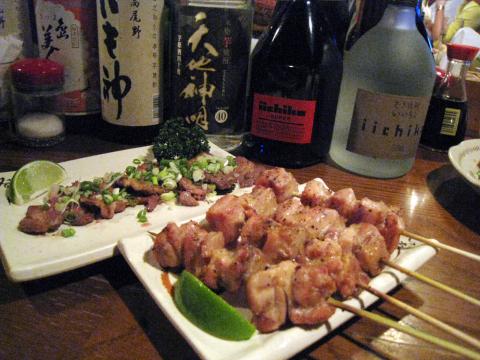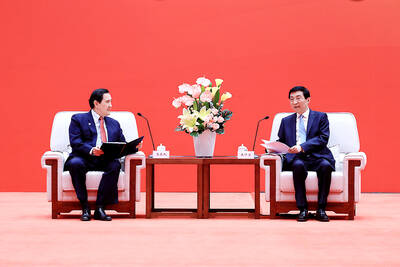Frayed menus, old beer posters and a large wooden bar set the mood at Furinkazan, a drinking establishment that has served Japanese-style pub grub in the vicinity of Taipei’s Linsen North Road (林森北路) for nearly 20 years. The restaurant’s clientele, mostly made up of office professionals and Japanese businessmen, come for the simple but well-prepared fare and the relaxed atmosphere — and they don’t mind paying a premium price.
Billed as a robatayaki, a type of izakaya (the Japanese version of a tapas bar) where patrons sit around an open hearth on which food is grilled, the bar is at best an updated version of the Japanese dining tradition, with an experienced, smiling staff replacing the usual wooden paddles. That said, the establishment is bathed in a nostalgic air and old-time charm with its old furnishings, atmospheric, yellowish lighting and a hearth where fish is hung to dry.
The restaurant’s specialty is grilled meat and skewer dishes. Served with teriyaki sauce for dipping, the chicken meat balls (雞肉丸NT$80) option lives up to its popularity among food bloggers, finely wedding the savory tenderness of minced meat and vegetables with the crunchiness of chopped chicken cartilage. Another popular item is the chicken skewer (雞肉串, NT$80), which has a slightly charred skin and juicy meat.

Photo: Ho Yi, Taipei Times
For a good companion for icy-cold beer, the grilled cuttlefish (烤小卷, NT$280) with its al-dente texture is a must-try. Have that instead of the forgettable grilled beef tongue (NT$280).
The grilled vegetable selection on the menu is as good, if not better, than the meat section. The round, chubby breed of eggplant (NT$150) from Japan is grilled to perfection by two young chefs manning the hearth. The staff will recommend that you dip bits of the eggplant in soy sauce, but I think it’s best to enjoy the vegetable sauce-free and let the smoky flavor run the show. Not to be outdone, the grilled corn (NT$150) is luscious with a dusting of salt and a glob of butter.
Like any good Japanese bar, Furinkazan stocks a selection of beer (NT$130 to NT$180), sake (NT$150 to NT$480) and shochu (NT$180). Try the homemade plum wine (NT$160), which is pleasantly light and fruity. But be careful with the homemade mulberry wine (NT$160), which is stronger than it might sound.
Do not despair if your drinking companions stand you up. The proprietors, a jovial couple, are always keen to entertain their guests with chitchat and toasts. Diners who sit around the bar can hardly be bored, especially with the husband, a natural-born comedian who seems to enjoy the limelight.
The verdict: The good food, convivial setting and sociable owners ensure this well-worn restaurant remains busy during the week and jam-packed on weekends. But all this comes with a hefty price tag — you’d be lucky to fill your belly for less than NT$1,000.

The canonical shot of an East Asian city is a night skyline studded with towering apartment and office buildings, bright with neon and plastic signage, a landscape of energy and modernity. Another classic image is the same city seen from above, in which identical apartment towers march across the city, spilling out over nearby geography, like stylized soldiers colonizing new territory in a board game. Densely populated dynamic conurbations of money, technological innovation and convenience, it is hard to see the cities of East Asia as what they truly are: necropolises. Why is this? The East Asian development model, with

Desperate dads meet in car parks to exchange packets; exhausted parents slip it into their kids’ drinks; families wait months for prescriptions buy it “off label.” But is it worth the risk? “The first time I gave him a gummy, I thought, ‘Oh my God, have I killed him?’ He just passed out in front of the TV. That never happens.” Jen remembers giving her son, David, six, melatonin to help him sleep. She got them from a friend, a pediatrician who gave them to her own child. “It was sort of hilarious. She had half a tub of gummies,

The wide-screen spectacle of Formula One gets a gleaming, rip-roaring workout in Joseph Kosinski’s F1, a fine-tuned machine of a movie that, in its most riveting racing scenes, approaches a kind of high-speed splendor. Kosinski, who last endeavored to put moviegoers in the seat of a fighter jet in Top Gun: Maverick, has moved to the open cockpits of Formula One with much the same affection, if not outright need, for speed. A lot of the same team is back. Jerry Bruckheimer produces. Ehren Kruger, a co-writer on Maverick, takes sole credit here. Hans Zimmer, a co-composer previously, supplies the thumping

There is an old British curse, “may you live in interesting times,” passed off as ancient Chinese wisdom to make it sound more exotic and profound. We are living in interesting times. From US President Donald Trump’s decision on American tariffs, to how the recalls will play out, to uncertainty about how events are evolving in China, we can do nothing more than wait with bated breath. At the cusp of potentially momentous change, it is a good time to take stock of the current state of Taiwan’s political parties. As things stand, all three major parties are struggling. For our examination of the